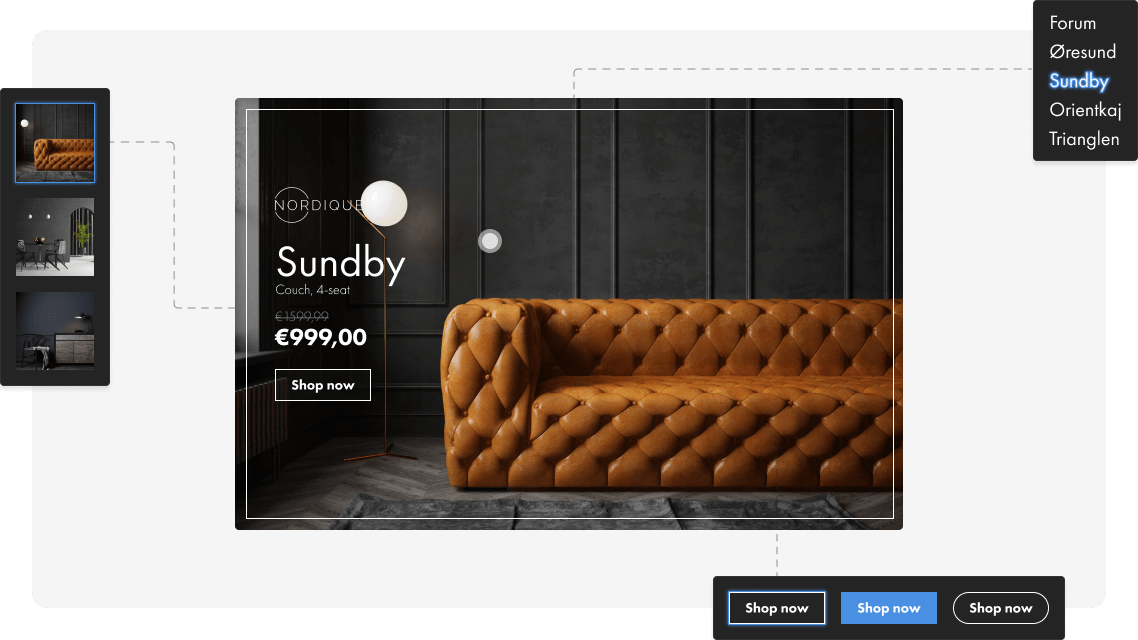What Can You Create with Zuuvi?
What is Dynamic Creative Optimisation (DCO)?
DCO is short for ‘dynamic creative optimisation’, and refers to a type of display ad technology that creates personalized ads based on data about the user currently viewing the ad. DCO ads typically surpass their static counterparts by a significant margin, since DCO ads are more widely tested and capable of optimising.
When considering the implementation of DCO ads, they are often preferred for the distribution of product advertisements. These types of banner adverts display dynamic content based on the user’s browsing history. This includes products previously displayed or even the ones added to a shopping cart on various sites.
However, DCO ads serve more than just this purpose, as they can also be utilized for surveys or to collect data for a company's campaign objectives. The targeting variables mostly used in connection with DCO ads are location, behavior, device, demography, and context.
Even though it might sound like a lot of variables are collected from the user, DCO’s collection of user data is still not classified as intrusive because any data source essentially can be linked to a dynamic ad.

How Does Dynamic Creative Optimization Work?
DCO advertising transforms standard advertising into a dynamic interaction between data and design. Here's how it unfolds:
Data Collection and Integration
The foundation of DCO advertising lies in its ability to collect and integrate huge amounts of user data. This data includes:
-
Browsing Habits: What websites users visit, how they navigate, and the content they engage with.
-
Purchase History: Insights into previous purchases, abandoned carts, and products viewed.
-
Demographic Details: Information such as age, gender, location, and interests.
By aggregating and analyzing this data, DCO advertising creates a comprehensive profile of each user. This profile is the base of the targeted creative process, allowing ads to be personalized to an unprecedented degree.
Advanced Algorithms
Once the user data is integrated, DCO advertising employs advanced algorithms to dynamically select and assemble the most relevant creative elements for each viewer. This process involves:
-
Component Selection: From a pre-designed set of creative assets (images, text, CTAs), the algorithm chooses the elements that best align with the user's profile.
-
Real-Time Adaptation: As the ad is about to be displayed, the system adapts these elements in real-time, ensuring that the final ad is perfectly tailored to the individual viewer.
This real-time assembly means that no two users will see the exact same ad, making DCO ads unique and engaging.
Power of Personalisation
The result of this dynamic process is a highly customized ad that resonates with the viewer based on their preferences. By tailoring the ad content to the specific interests, behaviours, and demographics of the user, DCO advertising maximises the relevance and impact of the ad. This personalized approach leads to:
-
Higher Engagement Rates: Users are more likely to interact with content that speaks directly to their needs and preferences.
-
Improved Conversion Rates: By delivering a message that is relevant and timely, DCO ads increase the likelihood of converting viewers into customers.

Working with DCO advertising in Zuuvi lets ad creators access unlimited creative options. Often DCO advertising platforms have complex targeting options but lack these creative opportunities. I'll give an example below:
Google Studio x Zuuvi
Google Studio has some real beefy targeting options that allow you to target your customers with pinpoint accuracy. However, if you were to design ads in Google Studio, you would need extensive coding experience, and you would still experience limited creative options.
That's why we decided to make a Google Studio x Zuuvi integration. This integration lets you get the best of both worlds - creative options and complex targeting opportunities. Read more about merging creativity with complex data intelligence by clicking below.
This seamless integration of data and creativity not only enhances user experience but also bolsters ad performance through precise targeting.
What are the Benefits of Using DCO Ads?
Adopting DCO ads in your ad creation can dramatically transform your digital campaigns, offering benefits such as:
-
Enhanced Relevance: DCO advertising allows you to create ads that resonate deeply with each individual user by dynamically assembling ad elements based on their preferences, behaviors, and demographics. This heightened relevance naturally leads to higher engagement rates, as users are more likely to interact with content that speaks directly to their interests.
-
Increased Conversion Rates: When your ads are highly relevant to your target audience, you're not just driving engagement – you're also increasing the likelihood of conversion. By delivering personalised messages that address users' specific needs and preferences, DCO ads can significantly boost conversion rates, translating engagement into tangible results for your business.
-
Boosted ROI: The combined impact of enhanced engagement and increased conversion rates can have a profound effect on your return on investment (ROI). By creating DCO ads, your ad spend can become more efficient and effective, as you're reaching the right audience with the right message at the right time.
- Reduces Ad Fatigue Dynamic Creative Optimisation (DCO) reduces ad fatigue and banner blindness by continuously varying ad content, ensuring users see fresh and relevant ads each time. By dynamically adjusting text, images, and offers based on individual user data, this prevents the boredom associated with repetitive static ads and enhances user interaction, maintaining their interest over time.
Want to know more about banner blindness and how to avoid it? I got you covered!
Also, DCO ads' ability to adapt in real-time reduces the need for extensive A/B testing, allowing for quicker optimisation and better resource allocation - which is pretty neat.
Those are the basics!
If you're already ready to get started with DCO ads, you can book a demo below and we'll show you how it all works.
Not quite there yet, ands still looking for just a bit more information on DCO ads? Then the next step is learning how to get started with your first DCO advertising campaign.





.webp?width=500&height=500&name=videoguide%20(1).webp)

